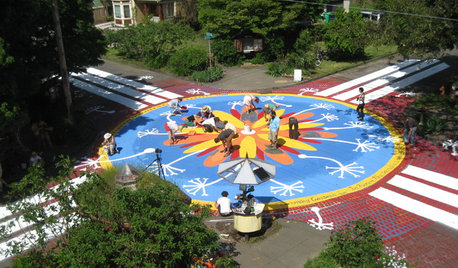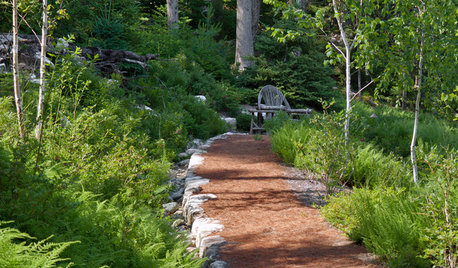Better way to make shredded leaf mulch?
jugglerguy
12 years ago
Featured Answer
Sort by:Oldest
Comments (25)
kittens
12 years agojoepyeweed
12 years agoRelated Discussions
is there an easier/better way to get leaves out of mulch
Comments (5)I'm looking for some advise in establishing a new perennial bed along a picket fence that is approx. 8-10 ft. from an oak tree. Although the shade is a real treat & opens many new options to me here in Florida, my problem being the ground is very difficult to cultivate due to loads of fine "feeder" roots under the soil. I am thinking I may be able to just boarder with rocks & raise the bed, which I am sure will also give my new plants a much better chance at success. Can I get some advise as to if weed block or black plastic should be used to keep the weeds (little trees) to a minimum if so, what depth should the bed be raised to so that the new plant roots are above the feeder roots & will it be necessary to add gravel etc. for drainage?...See MoreShredded leaves for mulch?
Comments (18)Personally I find shredding leaves to be a waste of energy. They do not work for me as a mulch that stays put unless you fence them in or pile something heavier on top of them. They're best in veggie gardens or perennial gardens that won't be cut back until spring so there's something to catch the leaves. I have too many leaves and not enough patience to shred them anymore. If you want to do that, you could use a mower with a bag attachment, a string trimmer in a garbage barrel, a leaf blower/mulcher or a dedicated leaf shredder. Leaves are a great (and free) organic additive to your soil though, so you should find a way to use them. I prefer to compost as many as I can (whole) and use them after they've broken down. That's so much easier. What falls on my beds stays there and I'll either work them into the soil come early spring or add them to my compost piles. I'll compost the perennials that have died back, too. While leaves are a good insulator, I agree with the matting comment and too many aren't a good thing. Any heavy accumulations of leaves should be raked out or spread around before it snows....See MoreDo you make leaf mulch?
Comments (2)I make huge amounts of leaf mulch and compost throughout the summer and now into fall. I'm just using up the last of the OPBL I collected last year (OPBL = other peoples' bagged leaves; must have had well over 100 bags). I'm lucky to own a MacKissic shredder and that makes the job easier and faster. The leaves break down much more quickly when shredded, but I have long-term leaf mold piles as well. (I'm a bit obsessive about it all, ha, but there are worse obsessions). Happy mulch-making. GaryStPaul...See MoreBacterial leaf spot, is there a better way, or overkill?
Comments (10)Hey esox, thx for chiming in, all feedback is welcome and gives me more ideas to brainstorm. The middle plants were getting the same sun, and at that point probably a similar amount of circulation since there was still space between the plants. I caught it this year earlier and before all the canopies connected, like they are now. It may be perception but it seems like the infection can cross a air-span of 6 inches to a foot (wind/rain), unless i'm wrong and it was being pulled in from the roots in those instances. I'm suspecting that there was either an infected spot there in the soil, or those plants were infected right from seed and waited for hot/rainy stressful weather to overcome the plant's immune system. It could also be dragged in via pants and shoes and maybe last years gardening tools unfortunately ( i don't recall disinfecting everything from last year). The stuff is pretty contagious from what i've been reading and experiencing....See Morejugglerguy
12 years agoalphonse
12 years agojoepyeweed
12 years agoKimmsr
12 years agonovascapes
12 years agojugglerguy
12 years agoalphonse
12 years agonovascapes
12 years agotoxcrusadr
12 years agojoepyeweed
12 years agoLloyd
12 years agotoxcrusadr
12 years agojugglerguy
12 years agoscotty66
12 years agobillums_ms_7b
12 years agodenno
12 years agobob64
12 years agoNevermore44 - 6a
12 years agorosehof
12 years agobatyabeth
12 years agooliveoyl3
12 years agoneen_5mi
12 years ago
Related Stories

GARDENING GUIDESNew Ways to Think About All That Mulch in the Garden
Before you go making a mountain out of a mulch hill, learn the facts about what your plants and soil really want
Full Story
GARDENING FOR BUTTERFLIES3 Ways Native Plants Make Gardening So Much Better
You probably know about the lower maintenance. But native plants' other benefits go far beyond a little less watering and weeding
Full Story
COMMUNITY15 Ways to Make Your Neighborhood Better
Does your community lack ... well, a sense of community? Here's how to strengthen that neighborly spirit
Full Story
GARDENING GUIDESHow to Pick a Mulch — and Why Your Soil Wants It
There's more to topdressing than shredded wood. Learn about mulch types, costs and design considerations here
Full Story
GARDENING GUIDESThe Art of Green Mulch
You can design a natural garden that doesn’t rely on covering your soil with wood and bark mulch
Full Story
GARDENING GUIDES5 Things to Know About Weeding and Mulching Your Native Garden
What’s the best time to pull weeds? How thick should the mulch be? Here’s the scoop for a healthy landscape
Full Story
FEEL-GOOD HOME10 Ideas to Make Every Day at Home a Little Better
Consider some simple changes and fun tips for brightening your world
Full Story
DECORATING GUIDESA Glimmer of Gold Leaf Will Make Your Room Shine
Make a unique, unexpected statement in any space with this precious metallic finish
Full Story

MOST POPULAR40 Dogs Who Are Having a Way Better Summer Than You
Houzzers share pics of their canine companions living it up — or getting down with relaxing — on warm days
Full Story



catherine_nm